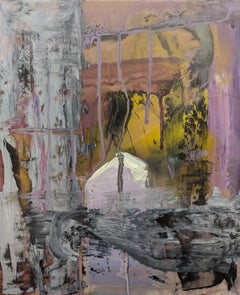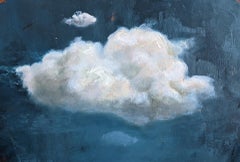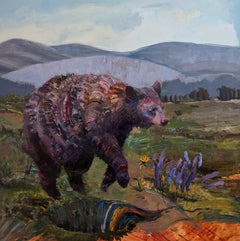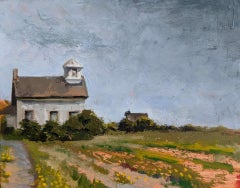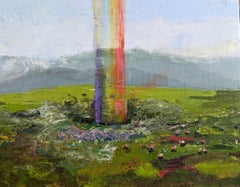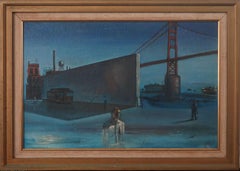Caitlin Hurd Art
to
4
13
13
1
Camp
By Caitlin Hurd
Located in Denver, CO
Camp
Category
21st Century and Contemporary Caitlin Hurd Art
Materials
Oil, Mylar
$900 Sale Price
25% Off
Cloud
By Caitlin Hurd
Located in Denver, CO
Cloud, 2020
Category
21st Century and Contemporary Caitlin Hurd Art
Materials
Oil, Paper
$640 Sale Price
20% Off
Bear I Am Afraid Of
By Caitlin Hurd
Located in Denver, CO
Bear I Am Afraid Of
Category
21st Century and Contemporary Caitlin Hurd Art
Materials
Oil, Canvas
View from the Nest
By Caitlin Hurd
Located in Denver, CO
View from the Nest
Category
21st Century and Contemporary Caitlin Hurd Art
Materials
Canvas, Oil
Church as Vacation Home
By Caitlin Hurd
Located in Denver, CO
Church as Vacation Home, 2020
Category
21st Century and Contemporary Caitlin Hurd Art
Materials
Oil, Panel
"Rainbow Hole" Oil Painting
By Caitlin Hurd
Located in Denver, CO
Caitlin Hurd's (US based) "Rainbow Hole" is an original, handmade oil painting that depicts a wide open grass plain where mountains sway majestically in the background and a rainbow shoots straight into the blue sky from a hole in the ground.
About the Artist:
Born 1978, in Massachusetts, Caitlin Hurd grew up in Salem and the suburbs north of Boston. In 2000, she received a BFA in furniture design from The Minneapolis College of Art and Design. She went on to lead school-age children in the creation of public murals for their communities. In 2006, she graduated with an MFA in painting from The New York Academy of Art. In 2017 Hurd founded the Artists Off Grid Residency program. She is also the founder of Spark Portraits, where she paints commissioned oil portraits from photographs...
Category
2010s Surrealist Caitlin Hurd Art
Materials
Wood, Oil
Up Hill
By Caitlin Hurd
Located in Denver, CO
Up Hill
Category
21st Century and Contemporary Caitlin Hurd Art
Materials
Oil, Mylar
$1,200
View From the Shed
By Caitlin Hurd
Located in Denver, CO
View From the Shed
Category
21st Century and Contemporary Caitlin Hurd Art
Materials
Canvas, Oil
$1,600 Sale Price
20% Off
Landscape I
By Caitlin Hurd
Located in Denver, CO
Landscape I
Category
21st Century and Contemporary Caitlin Hurd Art
Materials
Oil, Board
$1,660
Day at the Lake
By Caitlin Hurd
Located in Denver, CO
Day at the Lake
Category
21st Century and Contemporary Caitlin Hurd Art
Materials
Oil, Board
Landscape II
By Caitlin Hurd
Located in Denver, CO
Landscape II
Category
21st Century and Contemporary Caitlin Hurd Art
Materials
Oil, Board
$1,328 Sale Price
20% Off
The Great Sand Dunes National Park
By Caitlin Hurd
Located in Denver, CO
The Great Sand Dunes National Park
Category
21st Century and Contemporary Caitlin Hurd Art
Materials
Oil, Wood
Rainbow Valley
By Caitlin Hurd
Located in Denver, CO
Rainbow Valley
Category
21st Century and Contemporary Caitlin Hurd Art
Materials
Oil, Canvas
Related Items
Kobe Bryant Super BasketBall - One Of A Kind.
By Mauro Oliveira
Located in LOS ANGELES, CA
**STORE CLOSURE - UP TO 80% OFF - TAKE ADVANTAGE OF IT**
***EVERYTHING MUST GO BY DECEMBER 31ST!***
>>The artist is moving to a new full time venture in 2026<<
'Kobe Br...
Category
21st Century and Contemporary Pop Art Caitlin Hurd Art
Materials
Resin, Plexiglass, Rubber, Glitter, Acrylic
$850 Sale Price
66% Off
H 12 in W 10 in D 10 in
Mid Century San Francisco Nocturnal Surrealist Oil Painting
By Russell Tripp
Located in Soquel, CA
Mid Century Nocturnal Surrealist Oil Painting--San Francisco Unreal Dreams by Russell Tripp
Dramatic and atmospheric San Francisco surrealist figurative painting by Russell R. Tripp...
Category
1960s Surrealist Caitlin Hurd Art
Materials
Board, Oil
$1,875 Sale Price
25% Off
H 20.5 in W 28 in D 1.25 in
Alfred Jansson Signed Framed Oil Painting on Canvas, Sunlit Woodland Path
By Alfred Jansson
Located in Miami, FL
ALFRED JANSSON (1863-1931) – FOREST LANDSCAPE
Oil on Canvas ⚜ Signed ⚜ Dated ⚜ Framed
A STUNNING IMPRESSIONIST WOODLAND SCENE FROM 1909
This original oil painting by Alfred Jansson,...
Category
Early 1900s Impressionist Caitlin Hurd Art
Materials
Oil, Canvas
$12,000
H 30.25 in W 24.375 in D 2 in
Still Life Oil Painting on Canvas by Denis Paul Noyer, Framed
By Denis Paul Noyer
Located in Encino, CA
Untitled (Still Life), an original oil on canvas by Denis Paul Noyer, is a piece for the true collector. Noyer's use of red immediately captures the viewer, which serves as the backd...
Category
1960s Modern Caitlin Hurd Art
Materials
Oil, Canvas
$5,500
H 27.5 in W 31.75 in D 2 in
20th Century Surrealist Landscape Oil Painting
Located in Beachwood, OH
Surrealist Landscape
Oil on canvas
'R. Lee Glenn' verso
30 x 24.25 inches
31.75 x 26.75 inches, framed
Surrealism aims to revolutionize human experience. It balances a rational visi...
Category
20th Century Surrealist Caitlin Hurd Art
Materials
Oil
Riverscape Impressionist Oil Painting by George Thompson Pritchard, Framed
By George Thompson Pritchard
Located in Encino, CA
Untitled Riverscape, an original oil on canvas by George Thompson Pritchard, is a piece for the true collector. An impressively calming nature of this plein-air painting draws you in...
Category
1930s Impressionist Caitlin Hurd Art
Materials
Oil, Canvas
$8,000
H 31.375 in W 36.5 in D 2.25 in
Cooler Heads Prevail - Large Abstract Expressionist Textural Painting in Blue
Located in Los Angeles, CA
Los Angeles artist Marc Raphael's abstract expressionism paintings are influenced by New York's abstract expressionist movement. After encountering Jackson Pollock’s work for the fir...
Category
2010s Abstract Expressionist Caitlin Hurd Art
Materials
Canvas, Acrylic, Latex
Portrait of a Gentleman, Doublet & White Ruff, Gloves Inscribed 1624, on panel
By Frans Pourbus the Younger
Located in London, GB
Titan Fine Art presents this exquisite oil on panel portrait depicting a handsome young gentleman in an exuberant black damask doublet. The pose, with one hand holding gloves and the other akimbo, was one that was well-established for gentleman of the upper echelons of society by the time this work was painted. The principle governing portraits at this time was the recording and defining in visual terms of the position of a sitter in society. In addition to brilliant and complex symbols of luxury, they often contained many symbolic elements too; the inclusion of gloves was often used in portraits that celebrated a betrothal as in ancient times gloves were used to seal a marriage contract.
The extraordinary costume of a black shimmering doublet, the brilliant white reticella ruff, and the cuffs edged with lace were immensely costly… this attire proclaims to every onlooker that this is a superior being. The rendering of the reticella lace ruff is exquisite and the artist has recorded the design that runs through the black damask fabric with meticulous attention to detail. The preservation of this black pigment is remarkable considering the age of the work. Black pigments are especially vulnerable to fade and wear over time partly due to environmental condition but also from unprofessional cleaning. This work is an exquisite example from the period.
According to the inscription in the upper right, the gentleman was in his 22nd year of age in 1624. The coat of arms, which is displayed without a crest, may be ‘blazoned’ in the language of heraldry, as: Sable on a Chevron between in chief two Roundels and in base a Billet [or possibly Square] Or three Martlets Sable. In plainer English this means a black (Sable) background, spanned by a gold (Or) chevron, above which are two golden solid circles (Roundels), and below which is a gold rectangle (Billet); on the chevron are three small black birds (Martlets). Martlets are a stylised form of heraldic bird, believed to be based on the swift, which are conventionally drawn with small tufts instead of feet. In Continental Europe it is also conventional for them to be drawn without beaks, as appears to be the case here. The birds in this instance also have a vaguely duck-like appearance.
Five families have been identified with very close armorial bearings to the one in our portrait. They are the (van) Houthem’s (of Brabant), the Prévinaire’s (of Flanders and Holland), and the Proveneer’s (of Liège) and it must be noted that the locations of these families also fit with the painting’s Flemish origins. However the French Grenières’s (of Île-de-France) and the Jallot’s (of Normandy) are the next closest matches and plausible matches, as Frans Pourbus had settled in Paris just a few years before our portrait was painted.
This painting has been assessed by a professional conservator prior to going on sale, and as thus, it can be hung and enjoyed immediately.
Frans Pourbus the Younger...
Category
17th Century Old Masters Caitlin Hurd Art
Materials
Oil, Wood Panel
$17,909
H 42.13 in W 31.11 in D 3.94 in
Robert Kenneth White "Andalusian Afternoon" Signed Oil on Canvas Painting
Located in Miami, FL
ROBERT KENNETH WHITE – "ANDALUSIAN AFTERNOON"
⚜ Oil on Canvas ⚜ Hand Signed Lower Right and Titled on Verso ⚜ Frameless Display
MASTERFUL ARCHITECTURAL LANDSCAPE
Robert Kenneth Whit...
Category
2010s Realist Caitlin Hurd Art
Materials
Oil, Canvas
$4,900 Sale Price
30% Off
H 48 in W 36 in D 0.875 in
Robert Kenneth White "Island Goats" Oil on Canvas, 2018, Sunlit Rocky Grove
Located in Miami, FL
ROBERT KENNETH WHITE – "ISLAND GOATS"
Oil on Canvas ⚜ Hand Signed Lower Right ⚜ Frameless Display
A SUNLIT HERD IN A ROCKY GROVE
This compelling 2018 composition by Robert Kenneth ...
Category
2010s Realist Caitlin Hurd Art
Materials
Canvas, Oil
$5,800
H 32.125 in W 42 in D 2 in
"Elephant In The Pool" Lrg Orig. Oil Painting by Robert White, Frameless Display
Located in Encino, CA
“Elephant In The Pool,” an original oil on canvas by Robert K. White, is a piece for the true collector. White’s careful attention to detail and vivid use of greens, browns, and blue...
Category
2010s Realist Caitlin Hurd Art
Materials
Oil, Canvas
$8,500
H 40 in W 56.75 in D 1.25 in
Charles Levier [Solitude de Pierrot] signed large oil on canvas circa 1950
By Charles Levier
Located in Miami, FL
CHARLES LEVIER – [SOLITUDE DE PIERROT
⚜ Oil on Canvas ⚜ Hand Signed Lower Right ⚜ Original Period Frame
A THEATRICAL PORTRAIT OF MELANCHOLY
“Solitude de Pierrot” captures Charles Levier’s fascination with the archetypal Pierrot from commedia dell’arte. With angular black outlines and muted pastel tones, Levier reduces the figure to its essential gestures, creating a poignant symbol of isolation and quiet reflection. The vertical format emphasizes Pierrot’s elongated stance, while his downcast eyes and red-tipped nose heighten the painting’s emotive impact. This work was acquired directly from the artist by noted Beverly Hills designer Dean Richard Kukuk and retains its original Martin Lowitz Gallery label, underscoring both provenance and historical context.
WHY COLLECT THIS WORK?
✓ An early and expressive Charles Levier oil from circa 1950
✓ Features the Pierrot subject, connecting to the theatrical tradition of commedia dell’arte
✓ Strong provenance: Martin Lowitz Gallery, Los Angeles, and the collection of Dean Richard Kukuk, Beverly Hills
✓ Retains its original period frame in excellent condition with gallery label affixed verso
ARTWORK DETAILS:
▸ Title: [Solitude de Pierrot]
▸ Artist: Levier, Charles
▸ Medium: Oil on Canvas
▸ Creation Date: circa 1950
▸ Country of Creation: US
▸ Signed: Hand Signed Lower Right
▸ Current Condition: Excellent commensurate with age. Original period frame in great condition consistent with age.
▸ Documentation: Martin Lowitz Gallery label affixed to verso
▸ Provenance: Martin Lowitz Gallery, Los Angeles; Dean Richard Kukuk, Los Angeles
▸ Dimensions:
— ◼︎ Canvas Size: 44.25 inches x 15 inches
— ◻︎ Frame Size: 59 inches x 30 inches x 2.625 inches
INCLUDED DOCUMENTATION
✓ Certificate of Authenticity
✓ Artist Biography Document
THE ARTIST:
Charles Levier (1920–2003) was a French-American painter known for expressive oils, gouaches, and watercolors that bridge Modernism and postwar design sensibilities. His subjects include harbor towns, still lifes, café society, and commedia dell’arte figures such as Pierrot and Harlequin. Levier’s linear bite and stylized elongations have invited comparison to Bernard Buffet, while collectors of Modigliani, Rouault, and mid-century École de Paris painting...
Category
1950s Modern Caitlin Hurd Art
Materials
Canvas, Oil
Charles LevierCharles Levier [Solitude de Pierrot] signed large oil on canvas circa 1950, circa 1950
$9,500
H 59 in W 30 in D 2.625 in
Caitlin Hurd art for sale on 1stDibs.
Find a wide variety of authentic Caitlin Hurd art available for sale on 1stDibs. If you’re browsing the collection of art to introduce a pop of color in a neutral corner of your living room or bedroom, you can find work that includes elements of blue and other colors. You can also browse by medium to find art by Caitlin Hurd in oil paint, paint, canvas and more. Much of the original work by this artist or collective was created during the 21st century and contemporary and is mostly associated with the Surrealist style. Not every interior allows for large Caitlin Hurd art, so small editions measuring 9 inches across are available. Customers who are interested in this artist might also find the work of Peter Ellenshaw, Patrick Soper, and Piotr Butkiewicz. Caitlin Hurd art prices can differ depending upon medium, time period and other attributes. On 1stDibs, the price for these items starts at $640 and tops out at $7,100, while the average work can sell for $1,200.
Artists Similar to Caitlin Hurd
Questions About Caitlin Hurd Art
- Why is Peter Hurd famous?1 Answer1stDibs ExpertJanuary 27, 2025Peter Hurd is famous because of his landscape paintings depicting the American West and beyond. The landscape of New Mexico particularly inspired Hurd, and it was where he developed his artistic style. Hurd became celebrated for egg tempera, watercolors and lithographs. It was often from his field sketches that Hurd created his detailed tempera and watercolor pieces. Hurd’s adventurous spirit also took him all over the world, including in the mid-1940s when Hurd left home to serve as an illustrative war correspondent for LIFE magazine. The resulting wartime works varied from field sketches to fully developed egg tempera and watercolor works. Many of these war sketches now hang in the Pentagon. Find a selection of Peter Hurd art on 1stDibs.
